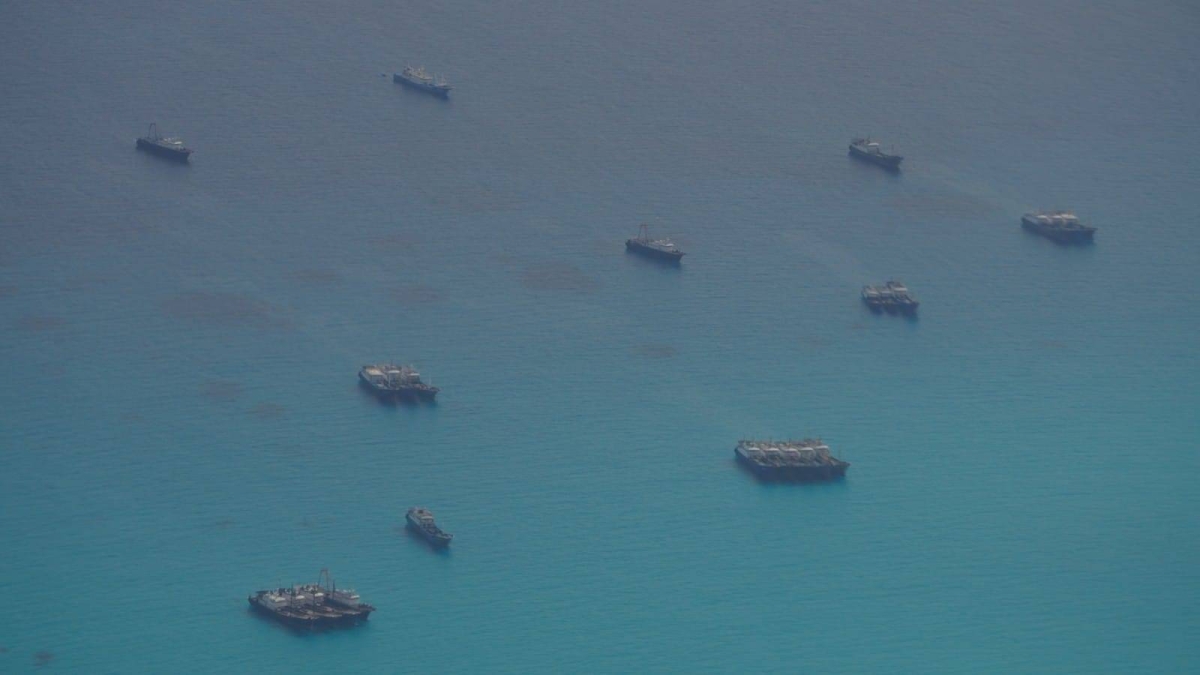(UPDATE) CLOSE to 30 Chinese fishing vessels (CFVs) have been massing at several locations in the West Philippine Sea (WPS), the Armed Forces of the Philippines (AFP) Western Command (Wescom) reported on Thursday.
The renewed swarming of Chinese boats could further fuel the already volatile situation in the WPS where incursions by Chinese coast guard (CCG) and maritime militia have become more frequent.

Photos from Western Command Armed Forces of the Philippines FB

Photos from Western Command Armed Forces of the Philippines FB
Wescom said aerial patrols conducted on September 6 and 7 spotted 23 CFVs in Rozul (Iroquois) Reef, five in Escoda (Sabina) Shoal, and two in Baragatan (Nares) Bank, which is about 100 nautical miles from Palawan province.
Escoda Shoal serves as a marker for the approach to Ayungin (Second Thomas) Shoal, where Chinese ships have been shadowing and harassing boats delivering supplies to the Philippine military station there, Wescom said.
Get the latest news
delivered to your inbox
Sign up for The Manila Times newsletters
By signing up with an email address, I acknowledge that I have read and agree to the Terms of Service and Privacy Policy.
“The increased presence of CFVs raises concerns regarding the potential implications for the Philippines’ maritime security, fisheries conservation, territorial integrity, and preservation of the marine environment. These activities have been a source of tension in the WPS and have contributed to instability in the region,” Wescom said in a statement.
Wescom said that on August 24, there were as many as 33 CFVs spotted in Rozul Reef.
Previous swarming incidents in the area were followed by reports of massive coral harvesting, raising concerns about the environmental damage it is causing, Wescom said.
“The repeated swarming incidents in both Rozul Reef and Escoda Shoal emphasize the continuous violation of Philippine sovereign rights and jurisdiction in its western border,” it said.
Wescom said “collaboration between the defense forces, law enforcement agencies, and international partners is crucial in addressing these challenges, upholding the Philippines’ sovereign rights and jurisdiction and maintaining stability in the region.” In March, a People’s Liberation Army Navy ship, a CCG vessel and at least 42 Chinese Maritime Militia vessels were sighted about 4.5 to 8 nautical miles from Pag-asa Island, well within the island’s 12-nautical-mile territory.
Last June 30, 48 Chinese fishing boats were sighted off Iroquois Reef, located south of the oil and gas-rich Recto Bank which lies within the Philippines’ exclusive economic zone.
Political analysts believe the intrusions were Beijing’s sharp response to Manila’s decision to allow the United States to station troops and military equipment in designated camps in the Philippines under the Enhanced Defense Cooperation Agreement (EDCA).
The US continues to upgrade the camps as part of the overall plan to beef up the Philippines’ defense posture.
On Thursday, the US started 63 more projects in the nine EDCA sites.
In a press briefing following the meeting of the Philippines-United States Mutual Defense Board (MDB) in Camp Aguinaldo, US Indo-Pacific Command Commander Admiral John Aquilino said 32 projects have been previously approved at the EDCA sites.
The United States has allotted over $100 million to fund the construction of facilities intended to modernize the camps and increase operational capability and interoperability with US assets.
Aquilino, along with AFP Chief of Staff Gen. Romeo Brawner Jr. and US Ambassador to the Philippines Marykay Carlson visited three EDCA sites — two in Cagayan Valley and one in Basa Air Base in Floridablanca, Pampanga — on Wednesday.
“We conducted an extensive tour of the completed EDCA projects and we were able to gain firsthand knowledge of the bases’ potential for the development of key facilities to support humanitarian assistance and disaster response operations,” Brawner said.
Aquilino said the MDB meeting “underscores the continued partnership and collaboration between the Philippines and the United States in enhancing national defense capabilities as well as the shared commitment to regional security.” The last MDB meeting was held in Hawaii last year.
Aquilino refused to go into detail when asked if the EDCA sites could be used to preposition weapons, given the heightened security situation not only in the WPS but also in the Taiwan Strait, where China has been threatening to invade the self-governed island.
He instead said both the US and Philippines have arrived at increasing cooperation and collaboration, viewed as important and foundational while setting up command centers and sharing of information.
>>> Read full article>>>
Copyright for syndicated content belongs to the linked Source : The Manila Times – https://www.manilatimes.net/2023/09/15/news/chinese-boats-renew-swarming-in-wps/1910052































